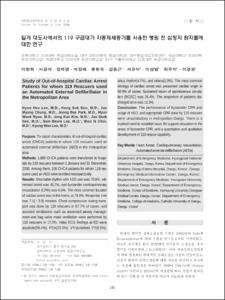KUMEL Repository
1. Journal Papers (연구논문)
1. School of Medicine (의과대학)
Dept. of Emergency Medicine (응급의학)
일개 대도시에서의 119 구급대가 자동제세동기를 사용한 병원 전 심정지 환자들에 대한 연구
- Keimyung Author(s)
- Choi, Woo Ik; Lee, Kyung Won
- Department
- Dept. of Emergency Medicine (응급의학)
- Journal Title
- 대한응급의학회지
- Issued Date
- 2008
- Volume
- 19
- Issue
- 3
- Abstract
- Purpose: To report characteristics of out-of-hospital cardiac arrest (OHCA) patients in whom 119 rescuers used an automated external defibrillator (AED) in the metropolitan area.
Methods: 1,689 OHCA patients were transferred to hospitals by 119 rescuers between 1 January and 31 December, 2006. Among them, 106 OHCA patients for whom 119 rescuers used an AED were enrolled retrospectively.
Results: Shockable rhythm with AED use was 70.8%, witnessed arrest was 46.2%, and bystander cardiopulmonary resuscitation (CPR) was 6.6%. The most common location of cardiac arrest was in the home, at 74.5%. Response time was 7.1(±3.9) minutes. Chest compression during transport was done by 119 rescuers in 87.7% of cases, and assisted ventilations such as advanced airway management and bag valve mask ventilation were performed by 119 rescuers in 17.0%. Initial ECG findings at ED were asystole(59.4%), PEA(25.5%), VF/pulseless VT(8.5%), sinus rhythm(4.7%), and others(1.9%). The most common etiology of cardiac arrest was presumed cardiac origin in 68.9% of cases. Sustained return of spontaneous circulation (ROSC) was 26.4%. The proportion of patients discharged alive was 11.3%.
Conclusion: The performance of bystander CPR and usage of AED, and appropriate CPR done by 119 rescuers were unsatisfactory in metropolitan Daegu. There is a marked need to establish basic life support education in the areas of bystander CPR, and a quantitative and qualitative development of 119 rescue capability.
- Alternative Title
- Study of Out-of-hospital Cardiac Arrest Patients for whom 119 Rescuers used an Automated External Defibrillator in the Metropolitan Area
- Publisher
- School of Medicine
- Citation
- 이현희 et al. (2008). 일개 대도시에서의 119 구급대가 자동제세동기를 사용한 병원 전 심정지 환자들에 대한 연구. 대한응급의학회지, 19(3), 245–252.
- Type
- Article
- ISSN
- 1226-4334
- Appears in Collections:
- 1. School of Medicine (의과대학) > Dept. of Emergency Medicine (응급의학)
- 파일 목록
-
-
Download
 oak-bbb-03040.pdf
기타 데이터 / 296.15 kB / Adobe PDF
oak-bbb-03040.pdf
기타 데이터 / 296.15 kB / Adobe PDF
-
Items in Repository are protected by copyright, with all rights reserved, unless otherwise indicated.